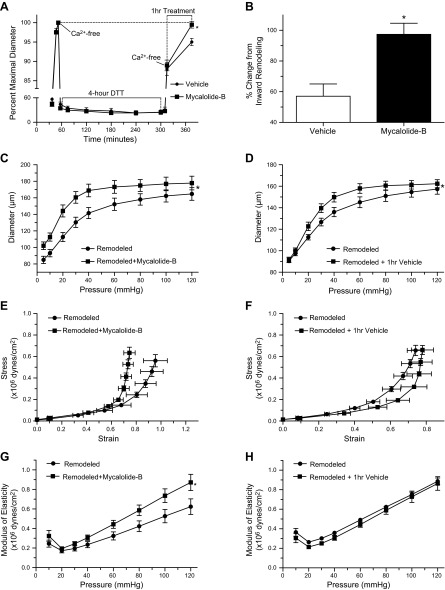Fig. 4.
Disruption of the actin cytoskeleton reverts the inward remodeling caused by prolonged exposure of isolated arterioles to DTT. A: arterioles were exposed to 200 μM DTT for 4 h. Before and after the 4-h incubation with DTT, arterioles were allowed to develop spontaneous tone and subsequently exposed to 10−4 M adenosine and then to calcium-free solution. After 5 min in the second exposure to calcium-free solution, arterioles were exposed for 1 h to vehicle control (n = 6) or 2 μM mycalolide-B (n = 6). Data are means ± SE of the maximal passive diameter obtained during the first exposure to calcium-free conditions. *P ≤ 0.05 vs. vehicle control. B: change in diameter caused by 1-h exposure to mycalolide-B (2 μM) or its vehicle control in arterioles whose passive diameter had been reduced by a 4-h exposure to 200 μM DTT. The percent reversal change was significantly greater in vessels exposed to mycalolide-B vs. vehicle controls (*P ≤ 0.05). C and D: pressure-diameter curves of DTT-inwardly remodeled arterioles before (remodeled, n = 7 in C and n = 5 in D) and after exposure (1 h) to 2 μM mycalolide-B (remodeled + mycalolide-B, n = 7) or its vehicle control (remodeled + vehicle, n = 5). *P ≤ 0.05 vs. remodeled + mycalolide-B or remodeled + vehicle. E and F: strain-stress relationships of DTT-inwardly remodeled arterioles before (remodeled, n = 7 in C and n = 5 in D) and after exposure (1 h) to 2 μM mycalolide-B (remodeled + mycalolide-B, n = 7) or its vehicle control (remodeled + vehicle, n = 5). G and H: incremental modulus of elasticity vs. pressure in DTT-inwardly remodeled arterioles before (remodeled, n = 7 in G and n = 5 in H) and after exposure (1 h) to 2 μM mycalolide-B (remodeled + mycalolide-B, n = 7) or its vehicle control (remodeled + vehicle, n = 5). *P ≤ 0.05 vs. remodeled + mycalolide-B.

